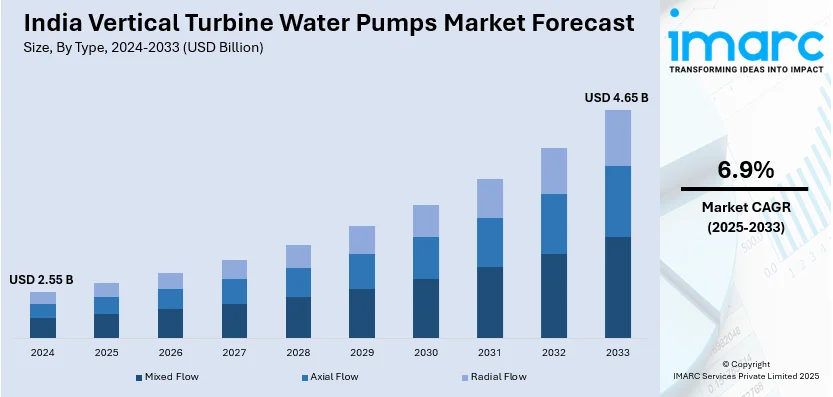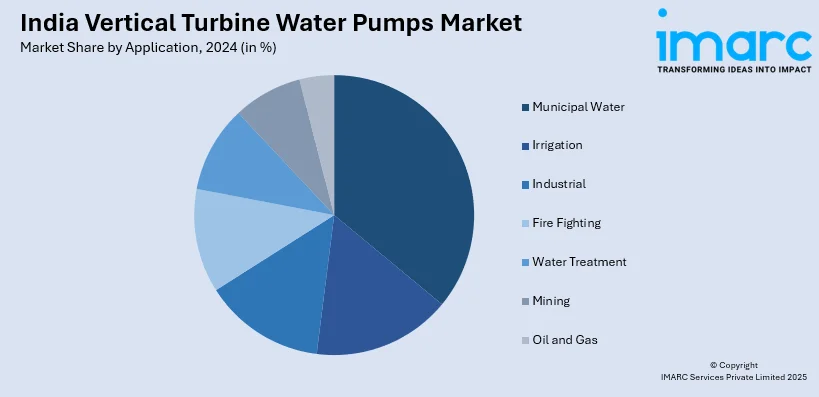
India Vertical Turbine Water Pumps Market Size, Share, Trends and Forecast by Type, Product, Application, Component, and Region, 2025-2033
India Vertical Turbine Water Pumps Market Overview:
The India vertical turbine water pumps market size reached USD 2.55 Billion in 2024. Looking forward, IMARC Group expects the market to reach USD 4.65 Billion by 2033, exhibiting a growth rate (CAGR) of 6.9% during 2025-2033. The increasing irrigation needs, rising industrialization, urban water supply expansion, wastewater treatment projects, government initiatives for infrastructure development, rapid urbanization, growing demand in power generation, and advancements in pump efficiency, durability, and energy-saving technologies are some of the factors propelling the growth of the market.
|
Report Attribute
|
Key Statistics
|
|---|---|
|
Base Year
|
2024 |
|
Forecast Years
|
2025-2033
|
|
Historical Years
|
2019-2024
|
| Market Size in 2024 | USD 2.55 Billion |
| Market Forecast in 2033 | USD 4.65 Billion |
| Market Growth Rate 2025-2033 | 6.9% |
India Vertical Turbine Water Pumps Market Trends:
Recognition Driving Demand for High-Efficiency Water Pump Solutions
International accolades for engineering excellence are boosting the global demand for high-performance water pump technologies. Prestigious awards highlight the contributions of industry leaders in developing efficient vertical turbine water pumps for irrigation, urban water supply, and wastewater management. Such recognition strengthens export opportunities, positioning India as a key player in advanced pump manufacturing. Governments and industries worldwide are increasingly adopting energy-efficient and durable solutions. As innovation and sustainability drive the sector forward, companies receiving such honors gain a competitive edge, reinforcing their expertise and commitment to engineering excellence in water management solutions across global markets. For example, in February 2025, CRI Pumps Private Limited was awarded the Engineering Export Promotion Council (EEPC) National Award for Export Excellence in the "Large Industry" category for FY2022. This recognition underscores CRI Pumps' significant contributions to India's engineering export sector. The company's expertise in vertical turbine water pumps has been demonstrated through high-impact projects, including water supply initiatives in Africa, irrigation projects in East Asia, and wastewater management systems in Europe.

To get more information of this market, Request Sample
Advanced Pump Technology Enhancing Agricultural Water Management
Innovative pump systems are transforming agricultural irrigation by optimizing water distribution across vast farmlands. Recent large-scale implementations demonstrate the effectiveness of vertical turbine pumps in efficiently channeling surplus water to drought-prone areas. This advancement benefits farming communities by ensuring reliable irrigation, increasing crop yields, and promoting sustainable water management. The adoption of high-performance fluid management solutions underscores the growing importance of technological innovation in agriculture. As climate challenges intensify, precision-engineered pumping systems are becoming essential for maintaining water security and enhancing productivity in rural regions, supporting millions of farmers reliant on consistent and efficient irrigation infrastructure. For instance, in March 2021, Kirloskar Brothers Ltd (KBL), a leading pump manufacturing company specializing in fluid management solutions, partnered with the Mettur Surplus Water Scheme, recently inaugurated by the Chief Minister of Tamil Nadu. KBL provided and installed vertical turbine pumps to enable water distribution across 100 lakes in the Sarbanga basin, covering 4,238 acres of farmland. This initiative aims to support over 16 lakh farmers in 40 villages, highlighting the significance of advanced pump technology in sustainable water management and agriculture.
India Vertical Turbine Water Pumps Market Segmentation:
IMARC Group provides an analysis of the key trends in each segment of the market, along with forecasts at the region/country level for 2025-2033. Our report has categorized the market based on type, product, application, and component.
Type Insights:
- Mixed Flow
- Axial Flow
- Radial Flow
The report has provided a detailed breakup and analysis of the market based on the type. This includes mixed flow, axial flow, and radial flow.
Product Insights:
- Canned Motor
- Submersible
- Line Shaft
A detailed breakup and analysis of the market based on the product have also been provided in the report. This includes canned motor, submersible, and line shaft.
Application Insights:

- Municipal Water
- Irrigation
- Industrial
- Fire Fighting
- Water Treatment
- Mining
- Oil and Gas
The report has provided a detailed breakup and analysis of the market based on the application. This includes municipal water, irrigation, industrial, fire fighting, water treatment, mining, and oil and gas.
Component Insights:
- Impellers
- Bowls
- Shafts
- Column Pipes
- Discharge Heads
A detailed breakup and analysis of the market based on the component have also been provided in the report. This includes impellers, bowls, shafts, column pipes, and discharge heads.
Regional Insights:
- North India
- South India
- East India
- West India
The report has also provided a comprehensive analysis of all the major regional markets, which include North India, South India, East India, and West India.
Competitive Landscape:
The market research report has also provided a comprehensive analysis of the competitive landscape. Competitive analysis such as market structure, key player positioning, top winning strategies, competitive dashboard, and company evaluation quadrant has been covered in the report. Also, detailed profiles of all major companies have been provided.
India Vertical Turbine Water Pumps Market News:
- In December 2020, Kirloskar Brothers Limited (KBL) supplied FM-approved and UL-listed fire-fighting pump sets to the 9-kilometer Atal Tunnel in Rohtang, Himachal Pradesh. This strategic all-weather tunnel, connecting Manali to Leh at 10,000 feet altitude, exemplifies 'Make in India' success. KBL's high-quality fire pump solutions, including end suction, split-case, multi-stage multi-outlet, and vertical turbine pumps, comply with National Fire Protection Association (NFPA) standards, ensuring stringent fire safety norms and cost-effectiveness.
India Vertical Turbine Water Pumps Market Report Coverage:
| Report Features | Details |
|---|---|
| Base Year of the Analysis | 2024 |
| Historical Period | 2019-2024 |
| Forecast Period | 2025-2033 |
| Units | Billion USD |
| Scope of the Report |
Exploration of Historical Trends and Market Outlook, Industry Catalysts and Challenges, Segment-Wise Historical and Future Market Assessment:
|
| Types Covered | Mixed Flow, Axial Flow, Radial Flow |
| Products Covered | Canned Motor, Submersible, Line Shaft |
| Applications Covered | Municipal Water, Irrigation, Industrial, Fire Fighting, Water Treatment, Mining, Oil and Gas |
| Components Covered | Impellers, Bowls, Shafts, Column Pipes, Discharge Heads |
| Regions Covered | North India, South India, East India, West India |
| Customization Scope | 10% Free Customization |
| Post-Sale Analyst Support | 10-12 Weeks |
| Delivery Format | PDF and Excel through Email (We can also provide the editable version of the report in PPT/Word format on special request) |
Key Questions Answered in This Report:
- How has the India vertical turbine water pumps market performed so far and how will it perform in the coming years?
- What is the breakup of the India vertical turbine water pumps market on the basis of type?
- What is the breakup of the India vertical turbine water pumps market on the basis of product?
- What is the breakup of the India vertical turbine water pumps market on the basis of application?
- What is the breakup of the India vertical turbine water pumps market on the basis of component?
- What are the various stages in the value chain of the India vertical turbine water pumps market?
- What are the key driving factors and challenges in the India vertical turbine water pumps market?
- What is the structure of the India vertical turbine water pumps market and who are the key players?
- What is the degree of competition in the India vertical turbine water pumps market?
Key Benefits for Stakeholders:
- IMARC’s industry report offers a comprehensive quantitative analysis of various market segments, historical and current market trends, market forecasts, and dynamics of the India vertical turbine water pumps market from 2019-2033.
- The research report provides the latest information on the market drivers, challenges, and opportunities in the India vertical turbine water pumps market.
- Porter's five forces analysis assist stakeholders in assessing the impact of new entrants, competitive rivalry, supplier power, buyer power, and the threat of substitution. It helps stakeholders to analyze the level of competition within the India vertical turbine water pumps industry and its attractiveness.
- Competitive landscape allows stakeholders to understand their competitive environment and provides an insight into the current positions of key players in the market.
Need more help?
- Speak to our experienced analysts for insights on the current market scenarios.
- Include additional segments and countries to customize the report as per your requirement.
- Gain an unparalleled competitive advantage in your domain by understanding how to utilize the report and positively impacting your operations and revenue.
- For further assistance, please connect with our analysts.
 Request Customization
Request Customization
 Speak to an Analyst
Speak to an Analyst
 Request Brochure
Request Brochure
 Inquire Before Buying
Inquire Before Buying




.webp)




.webp)












